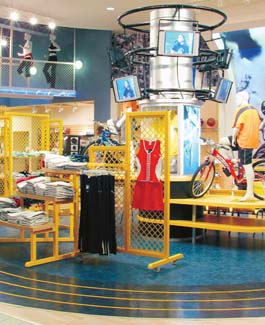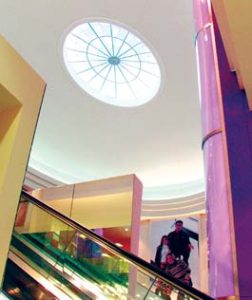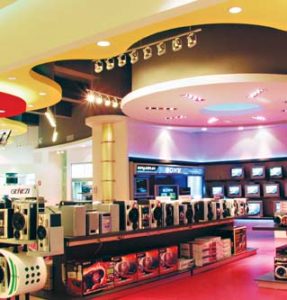At a glance, Siman department stores could be the kinds of Bloomingdale's or Saks Fifth Avenue projects store designer Jay Fitzpatrick developed in the U.S.
However, these stores are not in Mall of America or a New York suburb. They are open for business in the heart of Central America.
Fitzpatrick has been working for the last three years for the Almacenes Siman department store group in El Salvador, the most successful full-line department store retailer in the region.
Two of the newest stores represent the latest incarnation of Fitzpatrick's interpretation of president and group leader Ricardo Siman's vision. For Central America, Fitzpatrick says, “the vernacular is typically terra cotta floors, stucco and timber. Ricardo didn't want me to propagate what was already down there.”
The two new stores have near-identical floor plans and interior fixtures and finishes, but their façades were designed to suit the different aesthetics of the two developments. For “La Gran Via,” a 100,000 square-foot store that opened in 2004 in San Salvador, Fitzpatrick went with a more classic look reminiscent of European art deco buildings of the 1930s. For the 70,000-square-foot store in Galerias Santo Domingo, a shopping center soon to be completed in Managua, Nicaragua, Fitzpatrick took a modernist route, with a linear metal skin and jumbo fisheye windows complementing a futuristic shopping center porte cochere that suggests Star Wars landspeeders will be pulling up at any moment.
Since both these stores anchor their respective shopping centers, they needed to be monumental beacons. To achieve that effect, Siman directed Fitzpatrick to design both buildings to appear to be three levels. And ceilings are as much as 18 feet high, very unusual for Central American countries where 12-foot heights are standard.
Advertisement
The client had wanted three levels. As Doug Lamm, Siman's chief merchandiser, says, “when you have a two-level store, it appears flat from a distance.” Also, says Fitzpatrick, “the Siman people had been studying American department stores and saw mainly three levels. What they didn't realize is that the third level is always the least productive in the store.”
Siman wanted an American-style “real department store,” as Fitzpatrick characterizes it, “with lots of different merchandise – not just fashion-centric mini-boutiques – the kinds of stores that have, in fact, been disappearing in the U.S. In Siman stores, the merchandise assortment goes way beyond the usual ready-to-wear: stationery, electronics, sporting goods, toys, fabrics, furniture and food, a one-stop destination for the whole day.”
For Fitzpatrick, who is used to working both internationally and with American standards, designing for a different climate and culture had its advantages and its challenges. With the cheaper labor, more sumptuous materials could be specified. For instance, since marble is quarried locally, the façade of the “La Gran Via” building could be truly splendid, whereas in the States Fitzpatrick would have most likely had to substitute a more economical Dryvit material to stay within budget. Also, highly polished floors are less regulated in Central America, so dazzling finishes gleam everywhere, reflecting the lighting and illuminated accents.
On the other hand, lighting and climate control were major challenges: how to allow natural light in, while preventing the store from becoming an intolerably hot greenhouse in this equatorial zone? So glass façades and skylights were out. For both projects, Fitzpatrick and the local architects designed an ingenious stained glass oculus that acts as a sunscreen, appearing to let in direct sunlight while actually deflecting direct rays.
Distinct to both stores is Fitzpatrick's application of his copyrighted “coliseum” plan, first used in 1985 for the sixth floor of Bloomingdale's New York flagship. As Fitzpatrick explains it, “instead of straight or racetrack aisles, the aisles are curved and people circumnavigate the store. The 'coliseum plan' flows easily and new merchandise seems to unfold for you. There are no dead ends. It's more inviting to encounter new merchandise this way, rather than having to walk down long, straight aisles to nowhere – which most people naturally avoid.”
Fitzpatrick also brought American sensibilities to the visual logic and attractiveness of the departments. Typically, Central American stores are densely cluttered with merchandise and lots of small, vendor-provided graphics. Fitzpatrick suggested Siman use jumbo graphics to demarcate, helpfully direct and entice shoppers to various departments, not to cede all graphics to vendors. The resulting effect is visually logical and more attractive.
Advertisement
Central American retailers have always admired American-style design, and the department store concept in particular has long intrigued them. When the Siman stores opened, they were major events in the region, with people traveling from other cities and even other countries to come and shop in a newly minted local landmark. Fitzpatrick provided an All-American event.
Client: Almacenes Siman S.A. de C.V.
Ricardo Siman Dabdoub, president
Douglas Lamm, chief merchant
Patricia Esquivel de Quinonez, store planning manager
Rosendo Fuentes, project manager
Alexia Pineda de Arce, visual merchandising manager
Carolina Girón, store planning
Design/Architecture: Fitzpatrick International Group, Southampton, N.Y.
Jay Fitzpatrick, president and creative director
Visual Merchandising Consultant: Jeri Su, New York
Architect & General Contractor: La Gran Via
DNA, S.A. de C.V., San Salvador, El Salvador
Gerardo Dabdub Siman, president
Fernando Duran, project architect
Architect: Galerias Santo Domingo
Brasca Interiors, Guatemala City, Guatemala
Jose Luis Batres, principal
Advertisement
Ceilings: Loanfra, Guatemala City, Guatemala
Decoinsa, San Miguel, El Salvador
Fixtures: Huitzilin, Mexico D.F., Mexico
Flooring: Eurosal S.A. de C. V., Imola Ceramica. San Salvador, El Salvador
Lighting:Diaz Colocho Hns., Hubble Lighting Division, San Salvador, El Salvador
Mannequins/Forms: Actitudes, S.A. de C.V., Mexico D.F., Mexico
Publidec, S.A. de C.V., Mexico, D.F., Mexico
Mondo Mannequins, Hicksville, N.Y.
Props/Decoratives:Eximex Plus, S.A. de C.V. , Mexico,D.F., Mexico
Econoco Corp., Hicksville, N.Y.
Signage/Graphics: Sistemas Publicitarios S.A. de C.V., San Salvador, El Salvador
Foto impresiones S.A. De C. V., San Salvador, El Salvador
Wallcoverings and Materials: Designtex, New York
Righter Group, Wilmington, Mass.
Innovations in Wallcoverings, New York
Carpet: J&J Invisions, Dalton, Ga.
Plastic Laminate: Wilsonart Intl., Temple, Texas
Hardware: Capitol Hardware, Niles, Michigan
Vinyl Floors: Amtico Intl., Atlantic, Ga.
Metal Racks: Golden Rack Co. Ltd., Taiwan
Photography: Ferderico Trujillo, Fotique, San Salvador, El Salvador


 Photo Gallery2 days ago
Photo Gallery2 days ago
 Headlines1 week ago
Headlines1 week ago
 Headlines2 weeks ago
Headlines2 weeks ago
 Sector Spotlight2 weeks ago
Sector Spotlight2 weeks ago
 Headlines1 week ago
Headlines1 week ago
 Headlines4 days ago
Headlines4 days ago
 Headlines2 weeks ago
Headlines2 weeks ago
 Designer Dozen1 week ago
Designer Dozen1 week ago



















